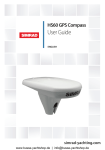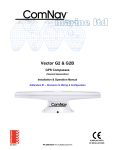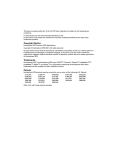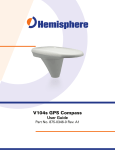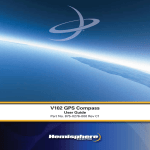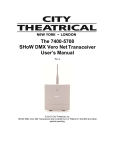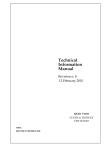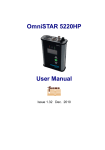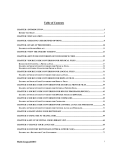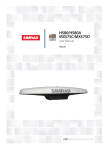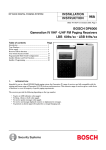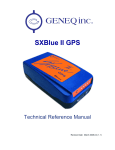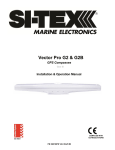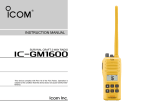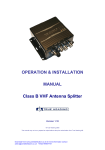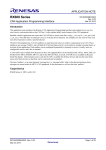Download Bild 1 - Seapilot
Transcript
Manual True Heading Vector Compact. Rev. 1.0 140918 This device complies with part 15 of the FCC Rules. Operation is subject to the following two conditions: (1) This device may not cause harmful interference, and (2) this device must accept any interference received, including interference that may cause undesired operation. Copyright Notice Copyright Hemisphere GNSS, Inc. (2014). All rights reserved. No part of this manual may be reproduced, transmitted, transcribed, stored in a retrieval system or translated into any language or computer language, in any form or by any means, electronic, mechanical, magnetic, optical, chemical, manual or otherwise, without the prior written permission of Hemisphere GNSS. Trademarks Hemisphere GNSS®, the Hemisphere GNSS logo, COASTTM, PocketMAXTM, Crescent® and VectorTM are proprietary trademarks of Hemisphere GNSS, Inc. Other trademarks are the properties of their respective owners. Patents Hemisphere GNSS products may be covered by one or more of the following patents: U.S. Patents 6111549 6876920 6397147 7142956 6469663 7162348 6501346 7277792 6539303 7292185 6549091 7292186 6711501 7373231 6744404 7388539 6865465 7400294 7400956 7429952 7437230 7460942 7689354 7808428 7835832 7885745 7948769 8000381 8018376 8085196 8102325 8138970 8140223 8174437 8184050 8190337 8214111 8217833 8265826 8271194 8307535 8311696 8334804 RE41358 Australia Patents 2002244539 2002325645 2004320401 Other U.S. and foreign patents pending. Notice to Customers Contact your local dealer for technical assistance. To find the authorized dealer near you: True Heading AB Vendevagen 90 S-182 32 Danderyd Phone: +46(8)6222660 [email protected] www.trueheading.se Technical Support If you need any technical suppoort, please contact True Heading at the above address. - BLANK PAGE - Vector Compact User Guide Vector Compact Contents Chapter 1 Introduction Overview . . . . . . . . . . . . . . . . . . . . . . . . . . . . . . . . . . . . . . . . . . . . . . . . . . . . 2 Parts List . . . . . . . . . . . . . . . . . . . . . . . . . . . . . . . . . . . . . . . . . . . . . . . . . . . . 3 Chapter 2 Vector Compact Installation Mounting Location . . . . . . . . . . . . . . . . . . . . . . . . . . . . . . . . . . . . . . . . . . . . . 6 GPS Reception . . . . . . . . . . . . . . . . . . . . . . . . . . . . . . . . . . . . . . . . . . . . . . . 6 Vector Compact Environmental Considerations . . . . . . . . . . . . . . . . . . . . . . 6 VHF Interference. . . . . . . . . . . . . . . . . . . . . . . . . . . . . . . . . . . . . . . . . . . . . . 7 Mounting Orientation . . . . . . . . . . . . . . . . . . . . . . . . . . . . . . . . . . . . . . . . . . . 9 Vector Compact Alignment . . . . . . . . . . . . . . . . . . . . . . . . . . . . . . . . . . . . . 11 Mounting Options. . . . . . . . . . . . . . . . . . . . . . . . . . . . . . . . . . . . . . . . . . . . . 12 Vector Compact Dimensions . . . . . . . . . . . . . . . . . . . . . . . . . . . . . . . . . . . 12 Cable Considerations . . . . . . . . . . . . . . . . . . . . . . . . . . . . . . . . . . . . . . . . . 14 Flush Mount . . . . . . . . . . . . . . . . . . . . . . . . . . . . . . . . . . . . . . . . . . . . . . . . 15 Pole Mount . . . . . . . . . . . . . . . . . . . . . . . . . . . . . . . . . . . . . . . . . . . . . . . . . 17 Powering and Connecting to the Vector Compact . . . . . . . . . . . . . . . . . . . . 20 Power Considerations. . . . . . . . . . . . . . . . . . . . . . . . . . . . . . . . . . . . . . . . . 20 Electrical Isolation . . . . . . . . . . . . . . . . . . . . . . . . . . . . . . . . . . . . . . . . . . . . 20 NMEA 2000 Port . . . . . . . . . . . . . . . . . . . . . . . . . . . . . . . . . . . . . . . . . . . . . 21 Contents Chapter 3 Operation GPS Overview . . . . . . . . . . . . . . . . . . . . . . . . . . . . . . . . . . . . . . . . . . . . . . 24 GPS Operation . . . . . . . . . . . . . . . . . . . . . . . . . . . . . . . . . . . . . . . . . . . . . . 24 Differential Operation . . . . . . . . . . . . . . . . . . . . . . . . . . . . . . . . . . . . . . . . . 25 Vector Compact Overview . . . . . . . . . . . . . . . . . . . . . . . . . . . . . . . . . . . . . 26 Supplemental Sensors . . . . . . . . . . . . . . . . . . . . . . . . . . . . . . . . . . . . . . . . 26 Time Constants . . . . . . . . . . . . . . . . . . . . . . . . . . . . . . . . . . . . . . . . . . . . . 29 Watchdog . . . . . . . . . . . . . . . . . . . . . . . . . . . . . . . . . . . . . . . . . . . . . . . . . . 29 Common Commands and Messages . . . . . . . . . . . . . . . . . . . . . . . . . . . . . 30 Warranty Notice . . . . . . . . . . . . . . . . . . . . . . . . . . . . . . . . . . . . . . . . . . . . . . . . . . . . 50 Vector Compact GPS Compass User Guide Chapter 1: Vector Compact Introduction Overview Parts List 1 Chapter 1: Introduction Overview The True Heading Vector Compact GPS Compass is based upon Hemisphere GNSS’ exclusive Crescent® and Crescent Vector™ II technology. The Vector Compact is a complete GPS compass and position system in a single enclosure that requires a standard NMEA 2000 cable connection. With NMEA 2000 support and ease of installation, the Vector Compact is the perfect solution for marine-based applications. The Vector Compact is an integrated system that houses the following: • Crescent and Crescent Vector II technology • Dual integrated GPS antennas • Power supply • Single axis gyro • Tilt sensor on each axis (X and Y axes) The gyro and tilt sensors are present to improve system performance and to provide backup heading information in the event that a GPS heading is not available due to signal blockage. Crescent Vector II technology supports multiple RF front ends - enabling tighter coupling of measurements from separate antennas for use in heading-based products. Users will achieve excellent accuracy and stability due to Crescent’s more accurate code phase measurements, improved multi-path mitigation, and fewer components. The Vector Compact’s GPS antennas are separated by 13.5 cm between their phase centers, resulting in better than 2° rms heading performance. The Vector Compact provides heading and position updates of up to 10 Hz and delivers position accuracy of better than 1.0 m 95% of the time when using differential GPS corrections from Space Based Augmentation Systems (SBAS). The Vector Compact also features Hemisphere GNSS’ exclusive COAST™ technology that enables Hemisphere GNSS receivers to utilize old differential GPS correction data for 40 minutes or more without significantly affecting the position quality. The Vector Compact is less likely to be affected by differential signal outages due to signal blockages, weak signals, or interference when using COAST. 2 Vector Compact GPS Compass User Guide If you are new to GPS and SBAS, refer to the GPS Technical Reference for further information on these services and technologies before proceeding. The GPS Technical Reference is available from True Heading AB. Please contact us at: [email protected] Parts List Note: The Vector Compact’s parts comply with IEC 60945 Section 4.4: “exposed to the weather.” Table 1-1: Parts list for Vector Compact Part Name Qty Part Number Vector Compact GPS Compass (NMEA 2000) 1 804-0128-0 Screw Housing Caps 2 675-0173-0 Mounting Screws 2 675-1199-000# Mounting Base 1 676-0035-0 Mounting Nut 1 676-1021-000# Screw Housing Cap O-Rings 2 681-1066-0 3 Chapter 1: Introduction - BLANK PAGE - 4 Vector Compact User Guide Chapter 2: Vector Compact Installation Mounting Location Mounting Orientation Mounting Options Powering and Connecting to the Vector Compact Connecting the V104 to External Devices 5 Chapter 2: Installation Mounting Location This section provides information on determining the best location for the Vector Compact. GPS Reception When considering where to mount the Vector Compact, consider the following GPS reception recommendations: • Ensure there is a clear view of the sky available to the Vector Compact so the GPS and SBAS satellites are not masked by obstructions that may reduce system performance. • Since the Vector Compact computes a position based on the internal GPS antenna element, mount the Vector Compact where you desire a position with respect to the GPS antenna (located on the side of the recessed arrow on the underside of the enclosure). • Locate any transmitting antennas away from the Vector Compact by at least several feet to ensure tracking performance is not compromised, giving you the best performance possible. • Make sure there is enough cable length to tie into the NMEA 2000 backbone of the vessel. • Do not locate the antenna where environmental conditions exceed those specified in Table B-5 on page 43. Vector Compact Environmental Considerations The Vector Compact is designed to withstand harsh environmental conditions; however, adhere to the following limits when storing and using the Vector Compact: • Operating temperature: -30°C to +70°C (-22°F to +158°F). • Storage temperature: -40°C to +85°C (-40°F to +185°F). • Humidity: 100% non-condensing. 6 Vector Compact User Guide VHF Interference VHF interference from devices such as cellular phones and radio transmitters may interfere with GPS operation. For example, if installing the Vector Compact near marine radios consider the following: • VHF marine radio working frequencies (Channels 1 to 28 and 84 to 88) range from 156.05 to 157.40 MHz. The L1 GPS working center frequency is 1575.42 MHz. The bandwidth is +/- 2MHz to +/- 10 MHz, which is dependent on the GPS antenna and receiver design (see next page). • VHF marine radios emit strong harmonics. The 10th harmonic of VHF radio, in some channels, falls into the GPS working frequency band, which may cause the SNR of GPS to degrade significantly. • The radiated harmonic signal strength of different brands/models varies. • Follow VHF radio manufacturers’ recommendations on how to mount their radios and what devices to keep a safe distance away. • Hand-held 5W VHF radios may not provide suitable filtering and may interfere with the Vector Compact’s operation if too close. 7 Chapter 2: Installation Before installing the Vector Compact use the following diagram to ensure there are no nearby devices that may cause VHF interference. VHF Antenna 1.5 m radius at top (minimum) Use these minimum distances to determine where to place the Vector Compact 1.0 m radius at base (minimum) Figure 2-1: Vector Compact distance from nearby VHF radios 8 Vector Compact User Guide Mounting Orientation The Vector Compact outputs heading, pitch, and roll readings regardless of the orientation of the antennas. The primary antenna is used for position.The primary and secondary antennas, working in conjunction, output heading, pitch, and roll values. Parallel Orientation: The most common installation is to orient the Vector Compact parallel to, and along the centerline of, the axis of the boat. This provides a true heading. In this orientation: • If you use a gyrocompass, you can enter a heading bias in the Vector Compact to calibrate the physical heading to the true heading of the vessel. • You may need to adjust the pitch/roll output to calibrate the measurement if the Vector is not installed in a horizontal plane. Perpendicular Orientation: You can also install the antennas so they are oriented perpendicular to the centerline of the boat’s axis. In this orientation: • You will need to enter a heading bias of +90° if the primary antenna is on the starboard side of the boat and -90° if the primary antenna is on the port side of the boat. • You will need to configure the receiver to specify the GPS antennas are measuring the roll axis. • You will need to enter a roll bias to properly output the pitch and roll values. • You may need to adjust the pitch/roll output to calibrate the measurement if the Vector is not installed in a horizontal plane. 9 Chapter 2: Installation . Forward motion Recessed arrow located on bottom of enclosure Figure 2-2: Recommended orientation and resulting signs of HPR values Recessed arrow located on bottom of enclosure Forward motion Figure 2-3: Alternate orientation and resulting signs of HPR values 10 Vector Compact User Guide Vector Compact Alignment The top of the Vector Compact enclosure incorporates sight design features to help you align the enclosure with respect to an important feature on your vessel. To use the sights, center the small post on the opposite side of the enclosure from you, within the channel made in the medallion located in the center of the enclosure top as shown in Figure 2-4 and Figure 2-5. Alignment accuracy when looking through the site (Figure 2-4)and (Figure 2-5) is approximately +/- 1°. Figure 2-4: Long site alignment channel Figure 2-5: Long sight alignment center post If you have another accurate source of heading data on your vessel, such as a gyrocompass, you may use its data to correct for a bias in Vector Compact alignment within the Vector Compact software configuration. Alternatively, you can physically adjust the heading of the Vector Compact so that it renders the correct heading measurement; however, adding a software offset is an easier process. 11 Chapter 2: Installation Mounting Options The Vector Compact allows for both pole or flush mounting. Follow directions below for detailed mounting directions. 12 Vector Compact User Guide Vector Compact Dimensions Figure 2-6 and Figure 2-7 illustrates the physical dimensions of the Vector Compact. Figure 2-6: Vector Compact dimensions 13 Chapter 2: Installation Figure 2-7: Vector Compact Dimensions with Adapter 14 Vector Compact User Guide Cable Considerations Before mounting the Vector Compact consider the following regarding cable routing: • Avoid running the cable in areas of excessive heat • Keep cable away from corrosive chemicals • Do not run the cable through door or window jams • Keep cable away from rotating machinery • Do not crimp or excessively bend the cable • Avoid placing tension on the cable • Remove unwanted slack from the cable at the Vector Compact end • Secure along the cable route using plastic wraps Improperly installed cable near machinery can be dangerous 15 Chapter 2: Installation Flush Mount The bottom of the Vector Compact contains two holes for flush mounting the unit to a flat surface (Figure 2-8). The flat surface may be something you fabricate per your installation, an off-the-shelf item (such as a radar mounting plate), or an existing surface on your vessel. Note: Hemisphere GNSS does not supply the mounting surface hardware. You must supply the appropriate fastening hardware required to complete the installation of the Vector Compact. Figure 2-8: Flush mounting with holes in the Vector Compact Note: You do not necessarily need to orient the antenna precisely as you can enter a software offset to accommodate for any bias in heading measurement due to installation. 16 Vector Compact User Guide Before flush mounting the Vector Compact • Determine your mounting orientation. See “Mounting Orientation” on page 9 for more information. • Choose a location that meets the mounting location requirements. • Using the fixed base as a template, mark and drill the mounting holes as necessary for the mounting surface. Flush mounting the Vector Compact 1. Mark the mounting hole centers and connector center on the mounting surface. 2. Place the Vector Compact over the marks to ensure the planned hole centers align with the true hole centers (adjusting as necessary). 3. Use a center punch to mark the hole centers. 4. Drill the mounting holes to a diameter of 6.8mm (0.26 in) appropriate for the surface. 5. Drill the connector hole to a diameter of 28.6mm (1.13 in) appropriate for the surface. 6. Pull the cable through the center connector hole and attach the cable directly to the Vector Compact, ensuring the connector is fastened securely to the unit. 7. Place the Vector Compact over the mounting holes and insert the mounting screws through the top of the Vector Compact and through the mounting surface. 8. Use two M6 washers and M6 nuts to secure the Vector Compact to the mounting plate (washers and nuts not included). When installing the Vector Compact, hand tighten only. Damage resulting from over-tightening is not covered by the warranty. 17 Chapter 2: Installation Pole Mount Before pole mounting the Vector Compact • Determine your mounting orientation. See “Mounting Orientation” on page 9 for more information. • Choose a location that meets the mounting location requirements. • Mark and drill the mounting holes as necessary for the threaded pole. Pole mounting instructions for Vector Compact (Inside Pole) 18 Vector Compact User Guide Required tools: 5 mm Allen key for M6 screws and adjustable wrench to tighten jam nut 1. Insert mating cable through both the jam nut and 1” (25.4mm) mounting adapter base 2. Place the jam nut on the pole followed by the 1” (25.4mm) adapter base. Hand tighten the base to the desired orientation. 3. Adjust the jam nut to secure the orientation. 4. Connect the mating end of the cable to the Vector Compact connector located on the bottom of the unit. 5. Insert the base adapter into Vector Compact by placing the tongue of the base into the groove of the Vector Compact unit. When the tongue is properly seated in the groove, the rest of the base can be pressed into place to create a smooth seam between the base and Vector Compact unit. 6. Use 5 mm Allen key to fasten two M6 screws to secure Vector Compact onto adapter. Use 15 in-lb torque 7. Insert each o-ring onto a plastic cap 8. Install plastic cap with o-ring onto Vector Compact unit (rectangular notch faced towards the outside) 9. Align and set the direction of Vector Compact unit, while using the jam nut to secure the unit (hand-tighten). Over-tightening may damage the system. This is not covered under warranty. Pole mounting instructions for Vector Compact (Outside Pole) 19 Chapter 2: Installation Required tools: 5 mm Allen key for M6 screws and adjustable wrench to tighten jam nut 1. Place the jam nut on the pole followed by the 1” (25.4mm) adapter base. Hand tighten the base to the desired orientation. 2. Adjust the jam nut to secure the orientation. 3. Run the cable throughout the vessel making sure to leave enough slack to mate the NMEA 2000 cable to both the NMEA 2000 backbone and the Vector Compact unit. 4. Run the NMEA 2000 cable through the opening in the side of the pole mounting adapter. And then connect the mating end of the cable to the V104 connector located on the bottom of the unit. 5. Insert the base adapter into Vector Compact by placing the tongue of the base into the groove of the Vector Compact unit. When the tongue is properly seated in the groove, the rest of the base can be pressed into place to create a smooth seam between the base and Vector Compact unit. 6. Use 5 mm Allen key to fasten two M6 screws to secure Vector Compact onto adapter. Use 15 in-lb torque 7. Insert each o-ring onto a plastic cap 8. Install plastic cap with o-ring onto Vector Compact unit (rectangular notch faced towards the outside) 9. Align and set the direction of Vector Compact unit, while using the jam nut to secure the unit (hand-tighten). Over-tightening may damage the system. This is not covered under warranty. 20 Vector Compact User Guide Connecting the NMEA 2000 cable 1. Align the NMEA 2000 cable connector key-way with the Vector Compact connector key. Key-way alignment 2. Rotate the cable ring clockwise until it is secured firmly to the unit (handtighten). Powering and Connecting to the Vector Compact Power Considerations For best performance, use clean and continuous power. The Vector Compact power supply features reverse polarity protection but will not operate with reverse polarity. See Table B-3 on page 43 for complete power specifications. Do not apply a voltage higher than 36 VDC. This will damage the receiver and void the warranty. Electrical Isolation The Vector Compact’s power supply is isolated from the communication lines and the PC-ABS plastic enclosure isolates the electronics mechanically from the vessel (addressing the issue of vessel hull electrolysis). 21 Chapter 2: Installation NMEA 2000 Cable Pin-out Specifications Figure 2-9 show the power/data cable pin-out, while Table 2-1 shows the cable’s pin-out specifications. Figure 2-9: NMEA 2000 cable pin assignment Table 2-1: NMEA 2000 cable pin-out Pin Function 1 Shield 2 Power Supply Positive (+V) 3 Power Supply Negative (-V) 4 CAN HI 5 CAN LOW NMEA 2000 Port The Vector Compact uses proprietary NMEA 2000 PGN for receiver configuration. Please contact [email protected] for a complete and up to date list of available proprietary PGN’s. With suitable USB-CAN hardware from Kvaser or PEAK, Vector Compact can be connected to a Windows PC to use PocketMax or VectorPC for configuration and setup using the same serial commands as the NMEA0183 Vector Compact. 22 Vector Compact User Guide Chapter 3: Vector Compact Operation GPS Overview Vector Compact Overview Common Commands and Messages 23 Chapter 3: Operation GPS Overview For your convenience, both the GPS and SBAS (WAAS, MSAS, GAGAN and EGNOS) operation of the Vector Compact features automatic operational algorithms. When powered for the first time, the Vector Compact performs a "cold start," which involves acquiring the available GPS satellites in view and the SBAS differential service. GPS Operation The GPS receiver is always operating, regardless of the DGPS mode of operation. The following sections describe the general operation of the Vector Compact’s internal GPS receiver. Note: Differential source and status have no impact on heading, pitch, or roll. They only have an impact on position and heave. Automatic Tracking The Vector Compact’s internal GPS receiver automatically searches for GPS satellites, acquires the signals, and manages the navigation information required for position and tracking. Receiver Performance The Vector Compact works by finding four or more GPS satellites in the visible sky. It uses information from the satellites to compute a position within 3 m. Since there is some error in the GPS data calculations, the Vector Compact also tracks a differential correction. The Vector Compact uses these corrections to improve its position accuracy to better than 1.0 m. There are two main aspects of GPS receiver performance: • Satellite acquisition • Position and heading calculation When the Vector Compact is properly positioned, the satellites transmit coded information to the antennas on a specific frequency. This allows the receiver to calculate a range to each satellite from both antennas. GPS is essentially a timing system. The ranges are calculated by timing how long it takes for the signal to 24 Vector Compact User Guide reach the GPS antenna. The GPS receiver uses a complex algorithm incorporating satellite locations and ranges to each satellite to calculate the geographic location and heading. Reception of any four or more GPS signals allows the receiver to compute three-dimensional coordinates and a valid heading. Differential Operation The purpose of differential GPS (DGPS) is to remove the effects of selective availability (SA), atmospheric errors, timing errors, and satellite orbit errors, while enhancing system integrity. Autonomous position capabilities of the Vector Compact will result in position accuracies of 3 m 95% of the time. In order to improve position quality to better than 1.0 m 95%, the Vector Compact is able to use differential corrections received through the internal SBAS demodulator. Automatic SBAS Tracking The Vector Compact automatically scans and tracks SBAS signals without the need to tune the receiver. The Vector Compact features two-channel tracking that provides an enhanced ability to maintain a lock on an SBAS satellite when more than one satellite is in view. This redundant tracking approach results in more consistent tracking of an SBAS signal in areas where signal blockage of a satellite is possible. 25 Chapter 3: Operation Vector Compact Overview The Vector Compact provides accurate and reliable heading and position information at high update rates. To accomplish this task, the Vector Compact uses a high performance GPS receiver and two antennas for GPS signal processing. One antenna is designated as the primary GPS antenna and the other is the secondary GPS antenna. Positions computed by the Vector Compact are referenced to the phase center of the primary GPS antenna. Heading data references the vector formed from the primary GPS antenna phase center to the secondary GPS antenna phase center. The heading arrow located on the bottom of the Vector Compact enclosure defines system orientation. The arrow points in the direction the heading measurement is computed (when the antenna is installed parallel to the fore-aft line of the vessel). The secondary antenna is directly above the arrow. Supplemental Sensors The Vector Compact has an integrated gyro and two tilt sensors. The gyro and tilt sensors are enabled by default. Both supplemental sensors are mounted on the printed circuit board inside the Vector Compact. The sensors act to reduce the search volume, which improves heading startup and reacquisition times. This improves the reliability and accuracy of selecting the correct heading solution by eliminating other possible, erroneous solutions. Table 3-1 on page 27 provides a sensor operation summary. 26 Vector Compact User Guide Table 3-1: Sensor operation summary Feature Normal Operation Coasting (no GPS) Heading GPS Gyro Pitch GPS Inertial sensor Roll Inertial sensor Inertial sensor Tilt Aiding The Vector Compact’s accelerometers (internal tilt sensors) are factory-calibrated and enabled by default. This allows for a steady heading solution beyond the volume associated with just a fixed antenna separation. This is because the Vector Compact knows the approximate inclination of the secondary antenna with respect to the primary antenna. The search space defined by the tilt sensor will be reduced to a horizontal ring on the sphere’s surface by reducing the search volume. This considerably decreases startup and reacquisition times (see Figure 3-1). Tilt angle Figure 3-1: Vector Compact’s tilt aiding Gyro Aiding The Vector Compact’s internal gyro offers several benefits. It reduces the sensor volume to shorten reacquisition times when a GPS heading is lost because the satellite signals were blocked. The gyro provides a relative change in angle since 27 Chapter 3: Operation the last computed heading, and, when used in conjunction with the tilt sensor, defines the search space as a wedge-shaped location (see Figure 3-2). Figure 3-2: Vector Compact’s gyro aiding The gyro aiding accurately smoothes the heading output and the rate of turn. It provides an accurate substitute heading for a short period depending on the roll and pitch of the vessel, ideally seeing the system through to reacquisition. The gyro provides an alternate source of heading, accurate to within 1º per minute for up to three minutes, in times of GPS loss for either antenna. If the outage lasts longer than three minutes, the gyro will have drifted too far and the Vector Compact begins outputting null fields in the heading output messages. There is no user control over the timeout period of the gyro. Calibration, which is set at the factory, is required for the gyro to remove latency from the heading solution as well as provide backup heading when GPS is blocked. The receiver will calibrate itself after running for a while but it may be important to follow the manual calibration instructions if you want to guarantee performance quickly after powering up the receiver. With the gyro enabled, the gyro is also used to update the post HTAU smoothed heading output from the GPS heading computation. This means that if the HTAU value is increased while gyro aiding is enabled, there will be no lag in heading output due to vehicle maneuvers. Hemisphere GNSS’ GPS Technical Reference includes information on setting an appropriate HTAU value for the application. Time Constants The Vector Compact incorporates user-configurable time constants that can provide a degree of smoothing to the heading, pitch, rate of turn (ROT), course 28 Vector Compact User Guide over ground (COG), and speed measurements. You can adjust these parameters depending on the expected dynamics of the vessel. For example, increasing the time is reasonable if the vessel is very large and is not able to turn quickly or would not pitch quickly. The resulting values would have reduced “noise,” resulting in consistent values with time. However, if the vessel is quick and nimble, increasing this value can create a lag in measurements. Formulas for determining the level of smoothing are located in Hemisphere GNSS’ GPS Technical Reference. If you are unsure on how to set this value, it is best to be conservative and leave it at the default setting. Note: For heading and rate of turn there is no lag once the gyro is calibrated and enabled. Rate of Turn (ROT) time constant: The default value of this constant is 2.0 seconds of smoothing. Increasing the time constant increases the level of ROT smoothing. Course Over Ground (COG) time constant: The default value of this constant is 0.0 seconds of smoothing. Increasing the time constant increases the level of COG smoothing. COG is computed using only the primary GPS antenna and its accuracy depends upon the speed of the vessel (noise is proportional to 1/speed). This value is invalid when the vessel is stationary, as tiny movements due to calculation inaccuracies are not representative of a vessel’s movement. Speed time constant: The default value of this constant is 0.0 seconds of smoothing. Increasing the time constant increases the level of speed measurement smoothing. Watchdog The watchdog is a timer that is controlled by the software that monitors if the heading is lost. The watchdog software is compliant with IEC 60945. 29 Chapter 3: Operation Common Commands and Messages Table 3-2 below through Table 3-3 provide brief descriptions of common NMEA commands and messages for the Vector Compact. Refer to the Hemisphere GNSS GPS Technical Reference for more detailed information Table 3-2: Received messages based on a request PG No. (PGN) 059392 Description ISO Acknowledgment Used to acknowledge the status of certain requests addressed to a specific ECU. 059904 ISO Request Request the transmission of a specific PGN, addressed or broadcast. 060928 ISO Address Claim Used to identify to other ECUs the address claimed by an ECU. 126996 Product Information NMEA 2000 database version supported, manufacturer’s product code, NMEA 2000 certification level, Load Equivalency number, and other product-specific information. 126464 Receive/Transmit PGNs group function The Transmit / Receive PGN List Group type of function is defined by first field. The message will be a Transmit or Receive PGN List group function. 129538 GNSS Control Status GNSS common satellite receiver parameter status. 30 Default Update Rate (msec) Freq. (Hz) On Request On Request On Request On Request On Request On Request On Request On Request On Request On Request On Request On Request Vector Compact User Guide PG No. (PGN) Description 129545 GNSS RAIM Output Autonomous Integrity Monitoring (RAIM) process. The Integrity field value is based on the parameters set in PGN 129546 GNSS RAIM settings. 129546 GNSS RAIM Settings Used to report the control parameters for a GNSS Receiver Autonomous Integrity Monitoring (RAIM) process. Default Update Rate (msec) Freq. (Hz) On Request On Request On Request On Request Freq. (Hz) Table 3-3: Transmitted messages. PG No. (PGN) Description Default Update Rate (msec) 126992 System Time 1000 1 100 10 100 10 The purpose of this PGN is twofold: to provide a regular transmission of UTC time, date, and to provide synchronism for measurement data. 127250 Vessel Heading Heading sensor value with a flag for True or Magnetic. If the sensor value is Magnetic, the deviation field can be used to produce a Magnetic heading, and the variation field can be used to correct the Magnetic heading to produce a True heading. 127251 Rate of Turn Rate of change of the Heading. 31 Chapter 3: Operation PG No. (PGN) 127257 Description Default Update Rate (msec) Freq. (Hz) Attitude 1000 1 1000 1 100 10 250 4 Provides a single transmission that describes the position of a vessel relative to both horizontal and vertical planes. This would typically be used for vessel stabilization, vessel control and on-board platform stabilization. 127258 Magnetic Variation Message for transmitting variation. The message contains a sequence number to allow synchronization of other messages such as Heading or Course over Ground. The quality of service and age of service are provided to enable recipients to determine an appropriate level of service if multiple transmissions exist. 129025 Position, Rapid Update Provides latitude and longitude referenced to WGS84. Being defined as single frame message, as opposed to other PGNs that include latitude and longitude and are defined as fast or multi-packet, this PGN lends itself to being transmitted more frequently without using up excessive bandwidth on the bus for the benefit of receiving equipment that may require rapid position updates. 129026 COG & SOG, Rapid Update Single frame PGN that provides Course Over Ground (COG) and Speed Over Ground (SOG). 32 Vector Compact User Guide PG No. (PGN) 129027 Description Default Update Rate (msec) Freq. (Hz) Position Delta, High Precision Rapid Update 100 10 100 10 1000 1 1000 1 1000 1 The “Position Delta, High Precision Rapid Update” Parameter Group is intended for applications where very high precision and very fast update rates are needed for position data. This PGN can provide delta position changes down to 1 mm with a delta time period accurate to 5 msec. 129028 Altitude Delta, High Precision Rapid Update The “Altitude Delta, High Precision Rapid Update” Parameter Group is intended for applications where very high precision and very fast update rates are needed for altitude and Course Over Ground data. This PGN can provide delta altitude changes down to 1 millimeter, a change in direction as small as 0.0057°, and with a delta time period accurate to 5 msec. 129029 GNSS Position Data Conveys a comprehensive set of Global Navigation Satellite System (GNSS) parameters, including position information. 129033 Time & Date Single transmission that provides UTC time, UTC Date, and Local Offset. 129539 GNSS DOPs Provides a single transmission containing GNSS status and dilution of precision components (DOP) that indicate the contribution of satellite geometry to the overall position error. There are three DOP parameters reported: horizontal (HDOP), vertical (VDOP), and time (TDOP). 33 Chapter 3: Operation PG No. (PGN) 129540 Description Default Update Rate (msec) Freq. (Hz) GNSS Sats in View 1000 1 1000 1 GNSS information on current satellites in view tagged by sequence ID. Information includes PRN, elevation, azimuth, SNR, defines the number of satellites; defines the satellite number and the information. 129542 GNSS Pseudorange Noise Statistics GNSS pseudorange measurement noise statistics can be translated in the position domain in order to give statistical measures of the quality of the position solution. Intended for use with a Receiver Autonomous Integrity Monitoring (RAIM) application Table 3-4: Single Frame packet definition - PGN: EFXX (Destination addressable) MSGIDs Description 0x0001 N2K,MCODE 0x0002 N2K,PCODE 0x0003 N2K,LOAD 0x0004 N2K,CERT 0x0005 JVERSION 0x0006 N2K,RESET 0x0007 N2K,ADDRESS 0x0008 JDIFF 0x0009 JDIFF,INCLUDE 0x000A JMODES 34 Vector Compact User Guide Table 3-4: Single Frame packet definition - PGN: EFXX (Destination addressable) MSGIDs Description 0x000B JSBASPRN 0x000C JBAUD,PORTx 0x000 JMASK 0x000E JATT,TILTAID 0x000F JATT,TILTCAL 0x0010 JATT,HBIAS 0x0011 JATT,PBIAS 0x0012 JATT,GYROAID 0x0013 JRESET 0x0014 JI, serial number 0x0015 JRAIM 0x0016 JATT,HIGHMP 0x0017 JAPP 0x0018 JAGE 0x0019 BIN1, stdev residuals 0x00A RD1 0x001B JK (read) 0x001C File Transfer Details 0x001 JWCONF,12 0x001E GNSS receiver boot loader reply messages 0x001F JI, application version 0x0020 JSYSVER 0x0021 JT 35 Chapter 3: Operation Table 3-4: Single Frame packet definition - PGN: EFXX (Destination addressable) MSGIDs Description 0x0022 JATT,MSEP 0x0023 JATT,CSEP 0x0024 ERROR 0x0025 NMEA 2000 Message Control 0x0026 JNP 0x0027 JSMOOTH 0x0028 JATT,HTAU 0x0029 JATT,HRTAU 0x002A JATT,COGTAU 0x002B JATT,SPDTAU 0x002C JATT,NEGTILT 0x002 JATT,FLIPBRD 0x002E JATT,LEVEL 0x002F JATT,MOVEBAS 0x0030 CANMODE 0x0031 GPHEV Heave 0x0032 JSAVE 0x0033 DIAGNOSTICS 0x0034 INTLT Raw Tilt Values Table 3-5: Multi-Frame Fast Packet definition: PGN: 1EFXX (Destination addressable) MSGIDs Description 0x8001 N2K,VERSION 36 Vector Compact User Guide Table 3-5: Multi-Frame Fast Packet definition: PGN: 1EFXX (Destination addressable) MSGIDs Description 0x8002 JK (write) 0x8003 JPOSOFFSET 0x8004 JVERSION 0x8005 JAUTH 0x8006 File Transfer Data Packet 0x8007 GNSS Boot loader Message 0x8008 Generic GNSS Serial Command 0x8009 RAW data transfer for differential 0x800A JI, Extended info 0x800B N2K,MODEL 37 Chapter 3: Operation - BLANK PAGE - 38 Vector Compact User Guide Appendix A: Vector CompactTroubleshooting 39 Appendix A: Troubleshooting Table A-1 provides troubleshooting for common problems. Table A-1: Troubleshooting Symptom Possible Solution Receiver fails to power • Check integrity of power cable connectors • Check power input voltage (6 to 36 VDC) • Check current restrictions imposed by power source (minimum available should be > 1.0 A) • Check receiver power status to ensure the receiver is powered (an ammeter can be used for this) • Check integrity and connectivity of power and data cable connections • Verify the Vector Compact has a clear view of the sky • Verify the lock status of GPS satellites • Verify the Vector Compact has a clear view of the sky • Verify the lock status of SBAS satellites No data from Vector Compact No GPS lock No SBAS lock Note: SBAS lock is only possible if you are in an appropriate SBAS region; currently, there is limited SBAS availability in the southern hemisphere. No heading or incorrect heading value • Heading is from primary GPS antenna to secondary GPS antenna, so the arrow on the underside of the Vector Compact should be directed to the bow side • Monitor the number of satellites and SNR values for both antennas - at least four satellites should have strong SNR values 40 Vector Compact User Guide Appendix B: Specifications 41 Appendix B: Specifications Table B-1 through Table B-5 provide the Vector Compact’s GPS sensor, communication, power, mechanical, and environmental specifications. Table B-1: GPS sensor specifications Item Specification Receiver type Vector GPS L1 Compass Channels Two 12-channel, parallel tracking (Two 10-channel when tracking SBAS) SBAS tracking 2-channel, parallel tracking Update rate 10 Hz standard (position and heading) Position accuracy Single Point1 1 m (95%) 2 3 m (95%) SBAS Heading accuracy 2° (RMS) Heave accuracy3 < 30 cm (RMS) Pitch/Roll accuracy 2° (RMS) Rate of turn 90°/s maximum Cold start < 60 s typical (no almanac or RTC) Warm start < 20 s typical (almanac and RTC) Hot start < 1 s typical (almanac, RTC, and position) Heading fix < 10 s typical (valid position) Compass safe distance 30 cm (11.8 in) Maximum speed 1,850 kph (999 kts) Maximum altitude 18,288 m (60,000 ft) 42 Vector Compact User Guide Table B-2: Communication specifications Item Specification Port NMEA 2000 Data I/O protocol NMEA 2000 and CANOpen Table B-3: Power specifications Item Specification Input voltage 8 to 36 VDC Power consumption ~ 2.0 W nominal Current consumption 165 mA @ 12 VDC Power isolation Isolated to enclosure Reverse polarity protection Yes Table B-4: Mechanical specifications Item Specification Enclosure UV resistant, white plastic, Geloy CR7520 (ASA) Dimensions (not including mount) 25.9 L x 12.9 W x 4.5 H (cm) 10.2 L x 5.1 W x 1.8 H (in) Dimensions (including mount) 25.9 L x 12.9 W x 12.8 H (cm) 10.2 L x 5.1 W x 5.0 H (in) Weight (not including mount) 0.42 kg (0.9 lb) Weight (including mount) 0.51 kg (1.1 lb) Table B-5: Environmental specifications Item Specification Operating temperature -30°C to +70°C (-22°F to +158°F) 43 Appendix B: Specifications Table B-5: Environmental specifications (continued) Item Specification Storage temperature -40°C to +85°C (-40°F to +185°F) Water and Dust IP69 Humidity 100% non-condensing Vibration IEC 60945 EMC CE (IEC 60945 Emissions and Immunity) FCC Part 15, Subpart B CISPR22F 1Depends on multipath environment, number of satellites in view, satellite geometry, no SA, and ionospheric activity. 2Depends on multipath environment, number of satellites in view, SBAS coverage and satellite geometry. 3Based on a 40-second time constant. 44 Vector Compact GPS Compass User Guide Vector Compact Index A reception 6 sensor specifications 42 gyro aiding 27 alarm watchdog 29 alignment 11 automatic SBAS tracking 25 tracking 24 H heave accuracy 42 HRTAU 29 C L COGTAU 29 commands (common) 30 common commands and messages 30 communication specifications 43 connect to a power source 20 course over ground time constant 29 long sight alignment 11 M flush mount 15 mechanical specifications 43 message (common) 30 mounting alignment 11 environmental considerations 6 flush mount 15 GPS reception 6 location 6 orientation 9 parallel orientation 9 perpendicular orientation 9 pole mount 17 VHF interference 7 G O GPS automatic SBAS tracking 25 automatic tracking 24 operation 24 overview 24 receiver performance 24 orientation for mounting 9 E electrical isolation 20 environmental considerations 6 specifications 43 environmental considerations 6 F P parallel mounting 9 part numbers 3 parts list 3 45 Index W perpendicular mounting 9 pole mount 17 power connecting to a power source 20 considerations 20 electrical isolation 20 specifications 43 watchdog 29 R rate of turn (ROT) time constant 29 receiver performance 24 RS-232 21 S sensor specifications 42 short site alignment 11 SPDTAU 29 specifications communication 43 environmental 43 GPS sensor 42 mechanical 43 power 43 speed time constant 29 supplemental sensors 26 T tilt aiding 27 time constants 29 COGTAU 29 HRTAU 29 SPDTAU 29 tracking automatic 24 automatic SBAS 25 troubleshooting 40 V VHF interference 7 46 Vector Compact Warranty Notice COVERED PRODUCTS: This warranty covers all products manufactured by True Heading AB and purchased by the end purchaser (the “Products”), unless otherwise specifically and expressly agreed in writing by True Heading AB. LIMITED WARRANTY: True Heading AB warrants solely to the end purchaser of the Products, subject to the exclusions and procedures set forth below, that the Products sold to such end purchaser and its internal components shall be free, under normal use and maintenance, from defects in materials, and workmanship and will substantially conform to True Heading AB’s applicable specifications for the Product, for a period of 12 months from delivery of such Product to such end purchaser (the ”Warranty Period”). Repairs and replacement components for the Products are warranted, subject to the exclusions and procedures set forth below, to be free, under normal use and maintenance, from defects in material and workmanship, and will substantially conform to True Heading AB’s applicable specifications for the Product, for 90 days from performance or delivery, or for the balance of the original Warranty Period, whichever is greater. EXCLUSION OF ALL OTHER WARRANTIES. The LIMITED WARRANTY shall apply only if the Product is properly and correctly installed, configured, interfaced, maintained, stored, and operated in accordance with True Heading AB’s relevant User’s Manual and Specifications, AND the Product is not modified or misused. The Product is provided “AS IS” and the implied warranties of MERCHANTABILITY and FITNESS FOR A PARTICULAR PURPOSE and ALL OTHER WARRANTIES, express, implied or arising by statute, by course of dealing or by trade usage, in connection with the design, sale, installation, service or use of any products or any component thereof, are EXCLUDED from this transaction and shall not apply to the Product. The LIMITED WARRANTY is IN LIEU OF any other warranty, express or implied, including but not limited to, any warranty of MERCHANTABILITY or FITNESS FOR A PARTICULAR PURPOSE, title, and non-infringement. LIMITATION OF REMEDIES. The purchaser’s EXCLUSIVE REMEDY against True Heading AB shall be, at True Heading AB’s option, the repair or replacement of any defective Product or components thereof. The purchaser shall notify True Heading AB or a True Heading AB’s approved service center immediately of any defect. Repairs shall be made through a True Heading AB approved service center only. Repair, modification or service of True Heading AB products by any party other than a True Heading AB approved service center shall render this warranty null and void. The remedy in this paragraph shall only be applied in the event that the Product is properly and correctly installed, configured, interfaced, maintained, stored, and operated in accordance with True Heading AB’s relevant User’s Manual and Specifications, AND the Product is not modified or misused. NO OTHER REMEDY (INCLUDING, BUT NOT LIMITED TO, SPECIAL, INDIRECT, INCIDENTAL, CONSEQUENTIAL OR CONTINGENT DAMAGES FOR LOST PROFITS, LOST SALES, INJURY TO PERSON OR PROPERTY, OR ANY OTHER INCIDENTAL OR CONSEQUENTIAL LOSS) SHALL BE AVAILABLE TO PURCHASER, even if True Heading AB has been advised of the possibility of such damages. Without limiting the foregoing, True Heading AB shall not be liable for any damages of any kind resulting from installation, use, quality, performance or accuracy of any Product. HEMISPHERE IS NOT RESPONSIBLE FOR PURCHASER’S NEGLIGENCE OR UNAUTHORIZED USES OF THE PRODUCT. IN NO EVENT SHALL True Heading AB BE IN ANY WAY RESPONSIBLE FOR ANY DAMAGES RESULTING FROM PURCHASER’S OWN NEGLIGENCE, OR FROM OPERATION OF THE PRODUCT IN ANY WAY OTHER THAN AS SPECIFIED IN True Heading AB’S RELEVANT USER’S MANUAL AND SPECIFICATIONS. True Heading AB is NOT RESPONSIBLE for defects or performance problems resulting from (1) misuse, abuse, improper installation, neglect of Product; (2) the utilization of the Product with hardware or software products, information, data, systems, interfaces or devices not made, supplied or specified by True Heading AB; (3) the operation of the Product under any specification other than, or in addition to, the specifications set forth in True Heading AB’ relevant User’s Manual and Specifications; (4) damage caused by accident or natural events, such as lightning (or other electrical discharge) or fresh/salt water immersion of Product; (5) damage occurring in transit; (6) normal wear and tear; or (7) the operation or failure of operation of any satellite-based position system or differential correction service; or the availability or performance of any satellite-based position signal or differential correction signal. THE PURCHASER IS RESPONSIBLE FOR OPERATING THE VEHICLE SAFELY. The purchaser is solely responsible for the safe operation of the vehicle used in connection with the Product, and for maintaining proper system control settings. UNSAFE DRIVING OR SYSTEM CONTROL SETTINGS CAN RESULT IN PROPERTY DAMAGE, INJURY, OR DEATH. The purchaser is solely responsible for his/her safety and for the safety of others. The purchaser is solely responsible for maintaining control of the automated steering system at all times. THE PURCHASER IS SOLELY RESPONSIBLE FOR ENSURING THE PRODUCT IS PROPERLY AND CORRECTLY INSTALLED, CONFIGURED, INTERFACED, MAINTAINED, STORED, AND OPERATED IN ACCORDANCE WITH True Heading AB’S RELEVANT USER’S MANUAL AND SPECIFICATIONS. True Heading AB does not warrant or guarantee the position and navigation precision or accuracy obtained when using Products. Products are not intended for primary navigation or for use in safety of life applications. The potential accuracy of Products as stated in True Heading AB literature and/or Product specifications serves to provide only an estimate of achievable accuracy based on performance specifications provided by the satellite service operator (i.e. US Department of Defense in the case of GPS) and differential correction service provider. True Heading AB reserves the right to modify Products without any obligation to notify, supply or install any improvements or alterations to existing Products. GOVERNING LAW. This agreement and any disputes relating to, concerning or based upon the Product shall be governed by and interpreted in accordance with the laws of the State of Arizona. OBTAINING WARRANTY SERVICE. In order to obtain warranty service, the end purchaser must bring the Product to a True Heading AB approved service center along with the end purchaser's proof of purchase. True Heading AB does not warrant claims asserted after the end of the warranty period. For any questions regarding warranty service or to obtain information regarding the location of any of True Heading AB approved service center, contact True Heading AB at the following address: True Heading AB Vendevagen 90 S-182 32 Danderyd Phone: +46(8) [email protected] www.trueheading.se - BLANK PAGE -





















































